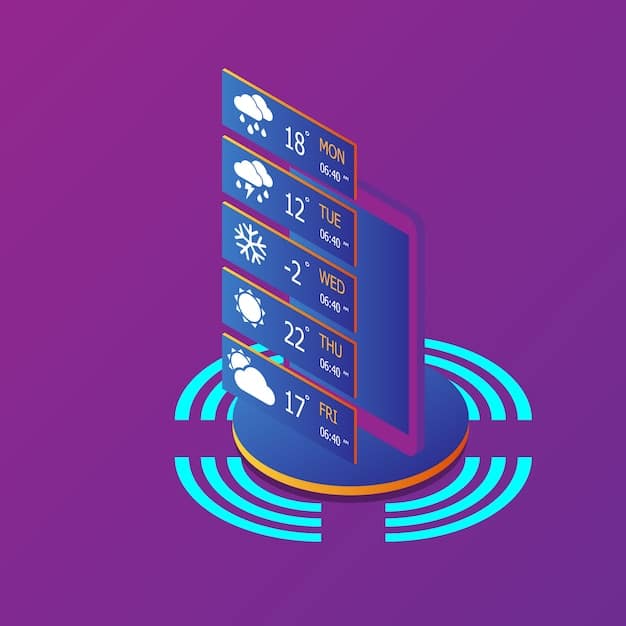Decoding Weather Alerts: Watches, Warnings, and Advisories Explained

Decoding weather alerts involves understanding the distinctions between watches, warnings, and advisories, each indicating different levels of threat and necessary actions to ensure safety during hazardous weather conditions.
Navigating the complexities of weather forecasts often involves encountering terms like watches, warnings, and advisories. Understanding the difference between decoding weather alerts can be critical for making informed decisions to protect yourself, your family, and your property from potentially dangerous weather conditions.
Decoding Weather Alerts: What You Need to Know
Weather alerts are issued by meteorological agencies to inform the public about potential or imminent hazardous weather conditions. These alerts come in different forms, each carrying specific implications and requiring different levels of action.
Knowing how to interpret these alerts can significantly enhance your preparedness and response to various weather-related threats. Let’s delve into the specifics of watches, warnings, and advisories.
The Purpose of Weather Alerts
Weather alerts serve as a crucial communication tool, bridging the gap between meteorological forecasts and public safety. They provide timely information that allows individuals and communities to take proactive steps to minimize risk and potential harm.
Who Issues Weather Alerts?
In the United States, the National Weather Service (NWS) is the primary authority responsible for issuing weather alerts. The NWS monitors weather patterns, analyzes data, and disseminates alerts through various channels, including radio, television, websites, and mobile apps.

- Watches: Indicate that conditions are favorable for a particular hazardous weather event to occur.
- Warnings: Signal that a hazardous weather event is imminent or already occurring.
- Advisories: Highlight less serious weather conditions that may still cause inconvenience or pose a risk.
By understanding the purpose and source of weather alerts, you can better appreciate their importance and take appropriate action when they are issued, which ultimately contributes to a safer and more weather-aware community.
Weather Watches: Be Prepared
A weather watch indicates that conditions are favorable for a specific hazardous weather event to occur in the specified area. It doesn’t mean that the event will definitely happen, but it does mean that you should be aware of the potential and be prepared to take action if needed.
Think of a watch as a heads-up, an opportunity to prepare for what might come. Let’s examine this in more detail.
What Does a Weather Watch Mean?
During a weather watch, conditions are ripe for severe weather. This could include thunderstorms, tornadoes, hurricanes, blizzards, or floods. The key is that the event is possible, not guaranteed.
Steps to Take During a Weather Watch
When a weather watch is issued, it’s time to start preparing. Here are some steps you can take:
- Stay Informed: Monitor weather updates from reliable sources like the National Weather Service.
- Review Emergency Plans: Ensure you and your family know what to do in case the watch escalates to a warning.
- Prepare Supplies: Gather necessary supplies such as food, water, medications, and a flashlight.
Examples of Weather Watches
To illustrate, consider these examples:
- Tornado Watch: Conditions are favorable for tornadoes to develop in the area.
- Hurricane Watch: A hurricane poses a possible threat to the area, typically within 48 hours.
- Flood Watch: Conditions are favorable for flooding in the area.
In summary, a weather watch is an alert that tells you to be prepared, stay informed, and review your emergency plans. It provides advance notice, giving you time to act preventatively.
Weather Warnings: Take Action Now
A weather warning is a more serious alert than a watch. It indicates that a hazardous weather event is imminent or is already occurring in the specified area. When a warning is issued, immediate action is necessary to protect life and property.
Warnings leave little room for hesitation. Here’s how to understand and respond to them.
What Does a Weather Warning Mean?
A weather warning means that a hazardous weather event is either occurring or is expected to occur very soon. This could include a tornado, hurricane, flash flood, or blizzard. The key distinction is that the threat is immediate.
Immediate Actions to Take During a Weather Warning
When a weather warning is issued, you should take the following steps immediately:
- Seek Shelter: If a tornado warning is issued, seek shelter in a basement, storm cellar, or an interior room on the lowest floor.
- Evacuate if Necessary: In the event of a flash flood warning, evacuate to higher ground immediately.
- Stay Indoors: During a blizzard warning, stay indoors and avoid travel.
Examples of Weather Warnings
To provide clarity, consider these examples:
- Tornado Warning: A tornado has been sighted or indicated by weather radar.
- Hurricane Warning: A hurricane is expected to make landfall in the area within a specified timeframe.
- Flash Flood Warning: Flash flooding is occurring or is imminent in the area.

In essence, a weather warning is a call to action. It means danger is imminent, and immediate steps must be taken to protect yourself and others. Understanding the specifics of the warning will guide your response.
Weather Advisories: Be Aware
Weather advisories are issued for less severe weather conditions that may cause inconvenience or pose a risk. While not as urgent as warnings, advisories still require attention and awareness to ensure safety.
Advisories serve as a reminder to take precautions during potentially hazardous, yet non-life-threatening weather events.
What Does a Weather Advisory Mean?
A weather advisory indicates that weather conditions are expected to cause significant inconvenience and may be hazardous. These conditions are typically less severe than those that trigger a warning but still warrant attention.
Precautions to Take During a Weather Advisory
When a weather advisory is issued, consider taking the following precautions:
- Exercise Caution: Be extra careful while driving, especially in rain, snow, or icy conditions.
- Dress Appropriately: Dress in layers to stay warm during cold weather advisories.
- Stay Informed: Monitor weather updates and adjust your plans accordingly.
Examples of Weather Advisories
To illustrate, consider these examples:
- Dense Fog Advisory: Fog is reducing visibility to a quarter mile or less, posing a risk to drivers.
- Heat Advisory: High temperatures and humidity may cause heat-related illnesses.
- Wind Advisory: Sustained winds of a certain speed are expected, which may make driving difficult.
In summary, a weather advisory is a signal to be aware of potentially inconvenient or hazardous weather conditions. While it may not require immediate action, it does call for caution and preparedness to mitigate risks.
Comparing Watches, Warnings, and Advisories
Understanding the distinctions between watches, warnings, and advisories is essential for effective weather preparedness. Each type of alert carries its own implications and requires a different level of response.
To further clarify, let’s compare these alerts side by side.
Key Differences
The primary differences between watches, warnings, and advisories lie in the severity and imminence of the weather threat:
- Watches: Indicate potential for hazardous weather; be prepared.
- Warnings: Indicate that hazardous weather is imminent or occurring; take immediate action.
- Advisories: Indicate less severe weather conditions that may cause inconvenience or pose a risk; be aware and exercise caution.
Timeline and Urgency
The timeline also differs among these alerts:
- Watches: Issued well in advance of potential weather events.
- Warnings: Issued shortly before or during a weather event.
- Advisories: Issued for conditions expected to develop or persist within a specific timeframe.
Severity of Impact
The expected impact also varies:
- Watches: Focus on the potential for significant impact if the weather event occurs.
- Warnings: Focus on the immediate and severe impact on life and property.
- Advisories: Focus on the potential for inconvenience and minor hazards.
By understanding these differences, you can better gauge the level of risk and take appropriate action based on the specific alert issued. This knowledge can significantly enhance your safety and preparedness in various weather scenarios.
Staying Safe During Different Weather Alerts
Knowing how to stay safe during different weather alerts is paramount for protecting yourself and your community. Each type of alert requires specific actions to mitigate potential harm.
Let’s explore the best strategies for staying safe during watches, warnings, and advisories.
Safety During a Weather Watch
During a weather watch, take the following precautions:
- Monitor Weather Updates: Stay tuned to reliable weather sources for the latest information.
- Review Emergency Plans: Ensure your family knows what to do in case the watch escalates to a warning.
- Prepare an Emergency Kit: Have essential supplies readily available, including food, water, medications, and a flashlight.
Safety During a Weather Warning
When a weather warning is issued, take immediate action:
- Seek Shelter: Go to a safe location, such as a basement, storm cellar, or an interior room on the lowest floor.
- Evacuate if Necessary: Follow evacuation orders issued by local authorities.
- Avoid Hazards: Stay away from windows, trees, and power lines.
Safety During a Weather Advisory
During a weather advisory, exercise caution and awareness:
- Drive Carefully: Reduce speed and increase following distance in adverse conditions.
- Dress Appropriately: Wear layered clothing to stay warm in cold weather or light, breathable clothing in hot weather.
- Stay Hydrated: Drink plenty of water to avoid dehydration during heat advisories.
By following these safety guidelines, you can significantly reduce your risk and ensure your well-being during different types of weather alerts. Remember, being prepared and staying informed are key to navigating hazardous weather conditions safely.
| Key Alert | Brief Description |
|---|---|
| 👀 Weather Watch | Conditions favor hazardous weather; prepare. |
| ⚠️ Weather Warning | Hazardous weather is imminent; take action. |
| 🍃 Weather Advisory | Be aware and exercise caution. |
| ☔️ Staying Safe | Monitor alerts, plan, and act accordingly. |
Frequently Asked Questions (FAQ)
▼
A severe thunderstorm watch means conditions are favorable for severe thunderstorms to develop. A severe thunderstorm warning means a severe thunderstorm is occurring or imminent, posing immediate threats like large hail and damaging winds.
▼
You can receive weather alerts through various channels, including the National Weather Service website, local news broadcasts, weather apps on your smartphone, and NOAA Weather Radio. Ensure that you have multiple ways to receive alerts.
▼
Your emergency kit should include essential supplies such as non-perishable food, bottled water, a flashlight, a battery-powered radio, extra batteries, a first-aid kit, medications, and personal hygiene items. Tailor the kit to your family’s specific needs.
▼
A flash flood is a rapid flooding of low-lying areas, typically caused by heavy rainfall. During a flash flood warning, seek higher ground immediately and avoid walking or driving through floodwaters. Remember, turn around, don’t drown.
▼
Stay informed by regularly checking weather forecasts from reliable sources, such as the National Weather Service or reputable weather apps. Pay attention to any alerts issued and adjust your plans accordingly. Being proactive can save lives.
Conclusion
Understanding the difference between weather watches, warnings, and advisories is crucial for staying safe and prepared in the face of potentially hazardous weather conditions. By knowing what each alert means and taking appropriate action, you can mitigate risks and protect yourself, your family, and your community.





